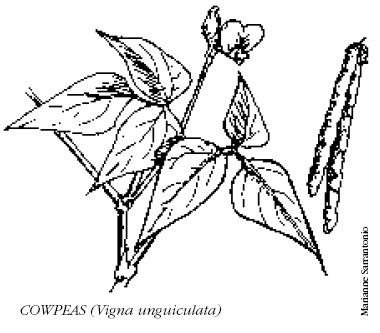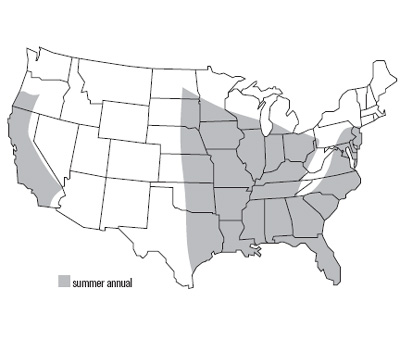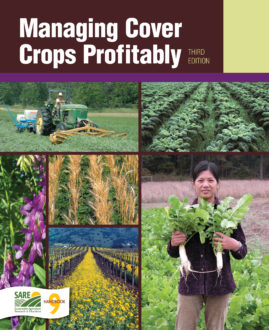
Cowpeas (Vigna unguiculata)
Also called: southern peas, blackeye peas, crowder peas, cow peas
Type: summer annual legume
Roles: suppress weeds, N source, build soil, prevent erosion, forage
Mix with: sorghum-sudangrass hybrid or foxtail hay-type millet for mulch or plow-down before vegetables; interseeded with corn or sorghum
See charts, pp. 66 to 72, for ranking and management summary.
Cowpeas are the most productive heat adapted legume used agronomically in the U.S. (275). They thrive in hot, moist zones where corn flourishes, but require more heat for optimum growth (263). Cowpea varieties have diverse growth habits. Some are short, upright bush types. Taller, viny types are more vigorous and better suited for use as cover crops. Cowpeas protect soil from erosion, smother weeds and produce 100 to 150 lb. N/A. Dense residue helps to improve soil texture but breaks down quickly in hot weather. Excellent drought resistance combined with good tolerance of heat, low fertility and a range of soils make cowpeas viable throughout the temperate U.S. where summers are warm or hot but frequently dry.
Cowpeas make an excellent N source ahead of fall-planted crops and attract many beneficial insects that prey on pests. Used in California in vegetable systems and sometimes in tree crops, cowpeas also can be used on poor land as part of a soil-building cover crop sequence.

Benefits of Cowpea Cover Crops
Weed-smothering biomass. Drilled or broadcast cowpea plantings quickly shade the soil to block out weeds. Typical biomass production is 3,000 to 4,000 lb./A (361). Cowpeas produced about 5,100 lb. drymatter/A in a two-year Nebraska screening of cover crops while soybeans averaged about 7,800 lb. DM/A in comparison plots (332).
Thick stands that grow well can outcompete bermudagrass where it does not produce seed and has been plowed down before cowpea planting (263). In New York, both cowpea and soybean provided some weed-suppressing benefits. Neither adequately controlled weeds, but mixing with buckwheat or sorghum-sudangrass improved performance as a weed management tool (43).
In California, cowpea mulch decreased weed pressure in fall-planted lettuce, while incorporated cowpea was less effective. An excellent desert cover crop, cowpea also reduced weed pressure in California pepper production (209).
The weed-suppressing activity of cowpea may be due, in part, to allelopathic compounds in the residue. The same compounds could adversely impact your main crop. Be sure to consult local information about impacts on cash crops.
Quick green manure. Cowpeas nodulate profusely, producing an average of about 130 lb. N/A in the East, and 200 lb. N/A in California. Properly inoculated in nitrogen deficient soils, cowpeas can produce more than 300 lb. N/A (120). Plowdown often comes 60 to 90 days after planting in California (275). Higher moisture and more soil N favor vegetative growth rather than seed production. Unlike many other grain legumes, cowpeas can leave a net gain of nitrogen in the field even if seed is harvested (361).
IPM insectary crop. Cowpeas have “extrafloral nectaries”—nectar-release sites on petioles and leaflets—that attract beneficial insects, including many types of wasps, honeybees, lady beetles, ants and soft-winged flower beetles (422). Plants have long, slender round pods often borne on bare petioles above the leaf canopy.
Intercropping cotton with cowpeas in India increased levels of predatory ladybugs and parasitism of bollworms by beneficial wasps. Intercropping with soybeans also increased parasitism of the bollworms compared with plots intercropped with onions or cotton without an intercrop. No effects on overall aphid, leafhopper or bollworm populations were observed (422).
Companion crop. Thanks to its moderate shade tolerance and attractiveness to beneficial insects, cowpeas find a place in summer cover crop mixtures in orchards and vineyards in the more temperate areas of California. Avoid use under a heavy tree canopy, however, as cowpeas are susceptible to mildew if heavily shaded (263). As in much of the tropical world where cowpeas are a popular food crop, they can be underseeded into corn for late-season weed suppression and postharvest soil coverage (361).
Seed and feed options. Cowpea seed (yield range 350 to 2,700 lb./A) is valued as a nutritional supplement to cereals because of complementary protein types. Seed matures in 90 to 140 days. Cowpeas make hay or forage of highest feed value when pods are fully formed and the first have ripened (120). A regular sickle-bar mower works for the more upright-growing cultivars (120, 422). Crimping speeds drying of the rather fleshy stems to avoid over-drying of leaves before baling.
Low moisture need. Once they have enough soil moisture to become established, cowpeas are a rugged survivor of drought. Cowpeas’ delayed leaf senescence allows them to survive and recover from midseason dry spells (21). Plants can send taproots down nearly 8 feet in eight weeks to reach moisture deep in the soil profile (107).
Cultivars for diverse niches. Cover crop cultivars include CHINESE RED, CALHOUN and RED RIPPER, all viny cultivars noted for superior resistance to rodent damage (317). IRON CLAY, a mixture of two formerly separate cultivars widely used in the Southeast, combines semi-bushy and viny plants and resistance to rootknot nematodes and wilt.
Most of the 50-plus commercial cowpea cultivars are horticultural. These include “crowder peas” (seeds are crowded into pods), grown throughout the temperate Southeast for fresh processing, and “blackeye peas,” grown for dry seed in California .Watch for the release of new varieties for cover crop use.
Use leafy, prostrate cultivars for the best erosion prevention in a solid planting. Cultivars vary significantly in response to environmental conditions. Enormous genetic diversity in more than 7,000 cultivars (120) throughout West Africa, South America and Asia suggests that breeding for forage production would result in improved cultivars (21, 422) and cover crop performance.
Easy to establish. Cowpeas germinate quickly and young plants are robust, but they have more difficulty emerging from crusted soils than soybeans.
Management of Cowpea Cover Crops
Establishment of Cowpea Cover Crops
Don’t plant cowpeas until soil temperature is a consistent 65° F and soil moisture is adequate for germination—the same conditions soybeans need. Seed will rot in cool, wet soils (107). Cowpeas for green manure can be sown later in summer (361), until about nine weeks before frost. Cowpeas grow in a range of well-drained soils from highly acid to neutral, but are less well adapted to alkaline soils. They will not survive in waterlogged soils or flooded conditions (120).
In a moist seedbed, drill cowpeas 1 to 2 inches deep at about 30 to 90 lb./A, using the higher rate in drier or cooler areas or for larger-seeded cultivars (361, 422). While 6- to 7-inch row spacings are best for rapid groundcover or a short growing season, viny types can be planted in 15- to 30-inch rows. Pay particular attention to pre-plant weed control if you go with rows, using pre-cultivation and/or herbicides.
If you broadcast seed, increase the rate to about 100 lb./A and till lightly to cover seed. A lower rate of 70 lb./A can work with good moisture and effective incorporation (361). Broadcast seeding usually isn’t as effective as drilling, due to cowpeas’ large seed size. You can plant cowpeas after harvesting small grain, usually with a single disking if weed pressure is low. No-till planting is also an option. Use special “cowpea ” inoculant which also is used for sunn hemp (Crotolaria juncea), another warm-season annual legume. See Up-and- Coming Cover Crops.
Field Management for Cowpea Cover Crops
Cowpea plants are sometimes mowed or rolled to suppress regrowth before being incorporated for green manure. It’s best to incorporate cowpeas while the entire crop is still green (361) for quickest release of plant nutrients. Pods turn cream or brown upon maturity and become quite brittle. Stems become more woody and leaves eventually drop.
Crop duration and yield are markedly affected by night and day temperatures as well as day length. Dry matter production peaks at temperatures of 81° F day and 72° F night (120).
Killing of Cowpea Cover Crops
Mowing at any point stops vegetative development, but may not kill plants without shallow tillage. Mowing and rolling alone do not consistently kill cowpeas (95). Herbicides can also be used. If allowed to go to seed, cowpeas can volunteer in subsequent crops.
Cowpeas Provide Elegant Solution to Awkward Niche
PARTRIDGE, Kan.—Cowpeas fill a rotational rough spot between milo (grain sorghum) and wheat for Jim French, who farms about 640 acres near Partridge, Kan.
“I miss almost a full season after we take off the milo in late October or November until we plant wheat the following October,” says French. “Some people use cash crops such as oats or soybeans. But with cowpeas, I get wind erosion control, add organic matter to improve soil tilth, save on fertilizer and suppress weeds for the wheat crop. Plus I have the options of haying or grazing.”
He chisel plows the milo stubble in late April, disks in May and field cultivates just before planting about the first week of June. He drills 30 to 40 lb./A of CHINESE RED cowpeas 1 to 2 inches deep when soil temperature reaches 70° F. Growth is rapid, and by early August he kills the cowpeas by making hay, having his cattle graze them off or by incorporating them for maximum soil benefit.
French says cowpeas usually produce about 90 to 120 lb. N/A —relatively modest for a legume cover—but he feels his soil greatly benefits from the residue, which measured 8,000 lb./A in one of his better fields. He disks the sprawling, leafy legume once, then does a shallow chisel plowing to stop growth and save moisture. Breakdown of the somewhat tough stems depends on moisture.
When he leaves all the cowpea biomass in the field, he disks a second time to speed decomposition. He runs an S-tine field cultivator 1 to 2 inches deep just before planting wheat to set back fall weeds, targeting a 20 to 25 percent residue cover. The cowpeas improve rainfall infiltration and the overall ability of the soil to hold moisture.
French observes that the timing of rainfall after cowpea planting largely determines the weediness of the cover crop. “If I get a week to 10 days of dry weather after I plant into moisture, the cowpeas will out-compete the weeds. But if I get rain a few days after planting, they’ll be weedy.”
French manages his legumes to stay in compliance with USDA farm program provisions. The Freedom to Farm Act allows vegetables used as green manure, haying or grazing to be planted on program acres, but prohibits planting vegetables for seed harvest on those acres. The rules list cowpeas as a vegetable, even though different cultivars are used for culinary production. Use of grain legumes such as lentils, mung beans and dry peas (including Austrian winter peas) is not restricted by the act, opening flexible rotation options.
French cooperated with Rhonda Janke of Kansas State University to define soil health more precisely. He can tell that covers improve the “flow” of his soil, and he is studying root growth after covers. But he feels her work measuring enzymes and carbon dioxide levels will give farmers new ways to evaluate microbial activity and overall soil health.
Pest Management for Cowpea Cover Crops
Farmers using cowpeas as cover crops do not report problems with insects that are pests in commercial cowpea production, such as Lygus bugs and 11-spotted cucumber beetle (95, 83). Insect damage to cowpea cover crops is most likely to occur at the seedling stage.
Once cowpea plants form pods, they may attract stinkbugs, a serious economic pest in parts of the lower Southeast. However, no significant stinkbug presence was reported in three years of screening in North Carolina. If stinkbugs are a concern, remember these points:
- Flail mowing or incorporating cowpeas at pod set will prevent a stinkbug invasion. By that time, cowpeas can provide good weed suppression and about 90 percent of their nitrogen contribution. However, waiting too long before mowing or incorporation will flush stinkbugs into adjacent crops. Leaving remnant strips of cowpeas to attract stinkbugs may reduce movement into other crops, as long as the cowpeas keep producing enough new pods until the cash crop is no longer threatened.
- Plan crop rotations so the preceding, adjacent and succeeding crops are not vulnerable or are resistant to stinkbugs.
- If you plan to use an insecticide to control another pest, the application may also help manage stinkbugs.
No cowpea cultivar is resistant to root rot, but there is some resistance to stem rot. Persistent wet weather before development of the first true leaf and crowding of seedlings due to poor seed spacing may increase damping off. To reduce disease and nematode risks, rotate with four or five years of crops that aren’t hosts. Also plant seed into warm soils and use certified seed of tolerant varieties (107). IRON and other nematode-tolerant cowpea cultivars reduced soybean cyst and rootknot nematode levels in greenhouse experiments (422). Despite some research (422) showing an increased nematode risk after cowpeas, California farmers report no such problem.
Crop Systems for Cowpea Cover Crops
Cowpeas’ heat-loving nature makes them an ideal mid-summer replenisher of soil organic matter and mineralizable nitrogen. Cowpeas set pods over a period of several weeks. Viny varieties continue to increase dry matter yields during that time.
A mix of 15 lb. cowpeas and 30 lb. buckwheat/ a makes it possible to incorporate the cover crop in just six weeks while still providing some nitrogen. Replacing 10 percent of the normal cowpea seeding rate with a fast-growing, drought-tolerant sorghum-sudangrass hybrid increases dry matter production and helps support the cowpea plants for mowing. Cowpeas also can be seeded with other tall annual crops such as pearl millet. Overseeding cowpeas into nearly mature spring broccoli in June in Zones 5 and 6 of the Northeast suppresses weeds while improving soil (361). Planting cowpeas in late June or early July in the upper Midwest after spring canning peas provides green manure or an emergency forage crop (422).
Cowpeas can fill a midsummer fallow niche in inland North Carolina between spring and summer vegetable crops. A mix of IRON AND CLAY cowpeas (50 lb./A) and German millet (15 lb./A) planted in late June can be killed mechanically before no-till transplanted fall broccoli. In several years of screening trials at the same sites, cowpea dry matter (3,780 lb./A) out yielded soybeans (3,540 lb. DM/A), but plots of sesbania (Sesbania exaltata) had top yields at about 5,000 lb. DM/A (95).
Comparative Notes
Cowpeas are more drought tolerant than soybeans, but less tolerant of waterlogging (361) and frost (263). Sown in July, the cowpea canopy closed more rapidly and suppressed weeds better than lespedeza (Lespedeza cuneata), American jointvetch (Aeschynomene americana), sesbania and alyceclover (Alysicarpus spp.), the other warm-season legumes tested (422).Cowpeas perform better than clovers and alfalfa on poor or acid soils. Cowpea residue breaks down faster than white sweetclover (361) but not as fast as Austrian winter peas.
Warm-season alternatives to cowpeas include two crops that retain some cowpea benefits. Buckwheat provides good beneficial habitat and weed control without attracting stinkbugs. Velvetbeans (Mucuna deeringiana) provide nitrogen, soil protection and late-season forage in hot, long-season areas. They do not attract stinkbugs and are resistant to nematodes (107).
